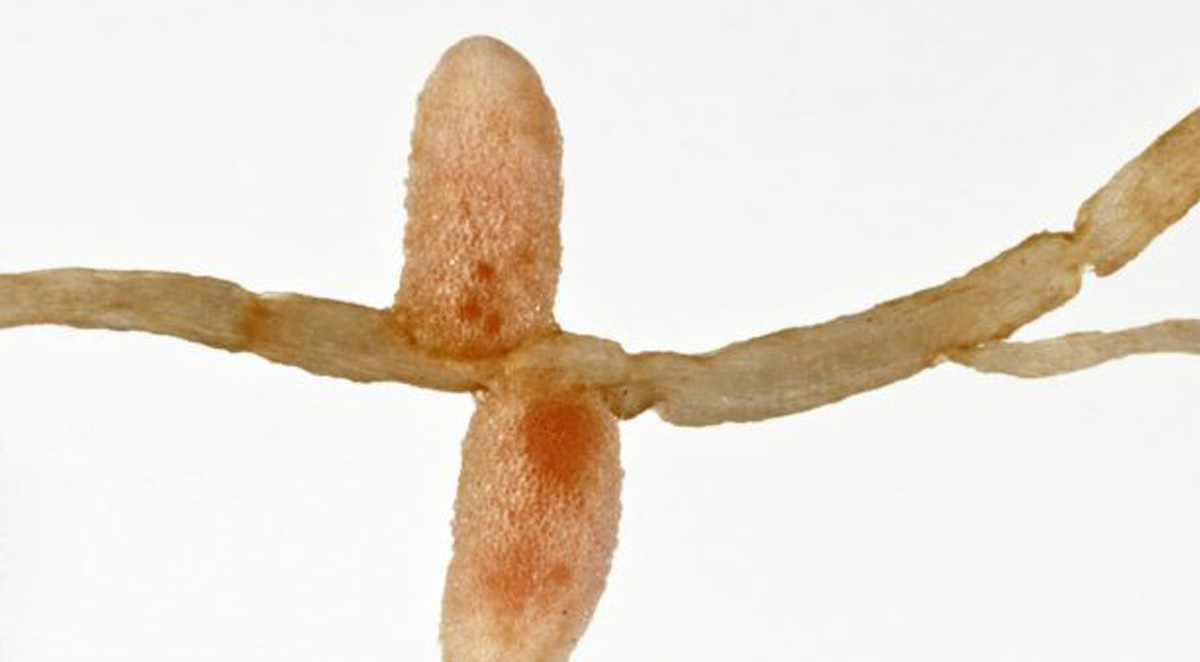
Scientists Discover How Legumes Give Oxygen to Symbiotic Bacteria in their Roots
November 3, 2021| |
Scientists have discovered the genetics of how legumes control the production of an oxygen-carrying molecule that is crucial to the plant's close relationship with nitrogen-fixing bacteria.
The roots of legumes are home to symbiotic bacteria that fix nitrogen from the air, turning it into ammonia, a key nutrient for plants. In return, the plants house the bacteria in root nodules, providing sugars and oxygen. The plant's solution to this ‘oxygen paradox of biological nitrogen fixation' is a molecule called leghemoglobin. Like hemoglobin that carries oxygen in our blood, leghemoglobin binds to oxygen and is red and gives legume nodules their pink color. Until now it's been unclear how plants control how much of this molecule is produced.
The research team identified two transcription factors that control how much leghemoglobin is made in legume nodules. Using Medicago truncatula, a model legume, the research team looked at a family of plant proteins with roles in nodulation. They looked at which proteins in this class are produced in symbiosis-housing nodules and found NIN and NLP2. When these two are inactive, nitrogen fixation is reduced, suggesting that they are involved in nitrogen fixation.
To investigate further, they grew plants in an aeroponic system to be able to look at the nodules and found the plants that lack NIN and NLP2 were smaller in size and had smaller and less-pink nodules. They also had lower levels of leghemoglobin. Further experiments found that NIN and NLP2 directly activate the expression of leghemoglobin genes.
For more details, read the press release from John Innes Centre.
| |
You might also like:
- Texas A&M Researchers Engineer Good Bacteria to Aid in Combating Disease
- Inactivation of Symbiotic Nitrogen Fixation Related Genes in Lotus Using CRISPR-Cas9
- Pocket K No. 46: Nitrogen Use Efficient Biotech Crops
Biotech Updates is a weekly newsletter of ISAAA, a not-for-profit organization. It is distributed for free to over 22,000 subscribers worldwide to inform them about the key developments in biosciences, especially in biotechnology. Your support will help us in our mission to feed the world with knowledge. You can help by donating as little as $10.
-
See more articles:
-
News from Around the World
- Global Climate Change Impact on Maize and Wheat Expected Within 10 Years, NASA Study Finds
- OFAB-Kenya Fetes Top Journalists in Science Media Awards
- USDA ARS Scientists Genetically Engineer Ever-Flowering Fruit to Feed Astronauts
- Study Confirms Effectiveness of Transgenic Coffee Against CBB
- Researchers Uncover "Genetic Goldmine" Allowing Plants to Live in Extreme Environment in the Atacama Desert
- Filipino Farmers Disagree on Banning of Biotech Crops
- 4th Asian Short Course on Agri-biotech, Biosafety Regulation, and Communication (ASCA2021)
- Food Futures: Commercialization of Gene Edited Crops in Asia and Australia
- Scientists Discover How Legumes Give Oxygen to Symbiotic Bacteria in their Roots
- European Scientists Call For Better Legislation on Genome-Edited Crops
-
Plant
- Researchers Venture into Gene Editing Research to Produce Improved Strawberries
- Heat-Moisture Treatment Improves Starch Content of Healthy Rice
-
Read the latest: - Biotech Updates (November 12, 2025)
- Gene Editing Supplement (October 29, 2025)
- Gene Drive Supplement (February 22, 2023)
-
Subscribe to BU: - Share
- Tweet

